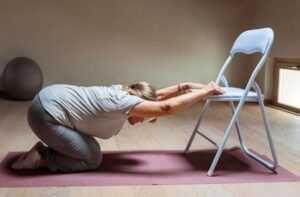
Maintaining your stability on your feet becomes increasingly crucial as you age.
Good coordination and balance serve to boost confidence, correct posture, and help prevent falls. But don’t worry if you find it difficult to move quickly or stand for extended periods. There are easy exercises you can do right from your chair.
Indeed, without standing up, seated workouts can help you develop strength, balance, and stability. For most seniors, these low-impact exercises are safe and straightforward to learn.
This article will discuss five low-impact seated exercises that can help enhance coordination and balance. Regardless of their level of fitness, they are ideal for anyone looking to stay active. Follow along!
1. Back Leg Raises
One of the most significant seated balanced exercises is back leg raises. Though basic, back-leg raises are effective. They help build the muscles of your buttocks and lower back. Particularly in walking or rising from a chair, these muscles are crucial for balance.
Sit straight on a firm chair with both feet flat on the floor to execute this exercise. For support, hang onto the chair’s sides. Keeping your foot flat and your knee just bent, slowly slip one leg back beneath the chair. Then, lift the leg just off the floor. Spend a few seconds holding it in the air, then gently bring it back down. On one leg, repeat this 10 to 15 times; then, turn to the other leg.
Try raising the leg longer as you grow strong. Go gently and take your time. This is not a race. It’s about control and softly working your muscles.
This workout targets the muscles you use daily and helps improve balance. Strong back and hip muscles will support you in standing, walking, and bending, as well as in maintaining your balance and stability.
2. Balancing Wand
Your hand-eye coordination and balance will improve with this easy and entertaining workout. All you need is a light object—a cane, a stick, or a broom handle. The aim is to keep it upright in your hand without allowing it to drop.
Start by sitting straight forward in a chair with both feet flat on the floor. One hand holds the stick or cane straight up. Place your open palm on its bottom. Try to keep it balanced there. Should it tip, gently adjust your hand to maintain its upright alignment. Practice one hand first; then, move to the other side.
Although it may seem basic, this exercise simultaneously engages multiple areas of your body and brain. It enhances hand strength, synergy between your eyes and hands, and concentration. Your hands will probably get more solid if you keep practising.
Relax if the stick falls frequently initially. That is included in the procedure. Your balance and reflexes will improve, and your control will become more refined with practice.
3. Shoulder Circles
Upper body balance and posture can both be improved with shoulder circles. Good posture maintains alignment of your head and spine, so it is vital. This keeps you balanced throughout the day and facilitates more natural movement.
Perform shoulder circles while seated tall in a solid chair. Ground both feet flat and let your arms rest by your sides. Lift both shoulders gradually toward your ears. Roll them back, then lower them in a large circle. Ten gentle repetitions of this motion will help. Then, flip directions; roll your shoulders forward for an additional ten circles.
Breathe in as you lift your shoulders and breathe out as you lower them, moving gently and slowly. Rushing is unnecessary. The intention is to release the muscles and increase the upper body’s range of motion.
Particularly if you spend a lot of time seated, this exercise helps release tension in your shoulders and neck. It also enhances how your upper body facilitates your movement. Your shoulders should be more in line, and your posture will help you feel more confident and balanced, whether walking or reaching for objects.
4. Seated Marching
One excellent approach to get your legs moving without standing up is seated marching. It improves hip and thigh strength, coordination, and balance.
Start by sitting in a chair with your feet flat on the ground. Keep your back straight and both feet flat on the ground. Holding onto the chair’s edges or softly resting your hands on your thighs, like in marching, now raise your right knee as high as you can. Come back down, then raise your left knee. Maintaining your pace, keep elevating one leg at a time, just as you would when marching in place.
March for thirty seconds to one minute. Start with 15 seconds and gradually build if that is too lengthy. You might even march along to the beat and play some music.
5. Toe and Heel Lifts
Toe and heel lifts help strengthen the muscles in your feet and lower legs. These muscles support your balance when standing, walking, or getting up from a chair. Strong feet make a big difference in staying steady.
Straighten yourself in your chair, feet flat on the floor. Keeping your heels down, gradually raise your toes off the ground. Spend a few seconds holding, then drop your toes. Keeping your toes down, raise your heels off the floor. Hold again, then lower them. Keep moving these ten to fifteen times every day.
As you perform this exercise, try to keep your body still overall. You are thus concentrating just on your lower legs and ankles.
This simple activity helps improve your balance, strengthens your ankles, and promotes circulation. It’s also a fantastic warm-up or cool-down exercise. Best of all, you can do it anywhere—at the kitchen table, while watching TV, or waiting for a phone call.
Conclusion
Staying active doesn’t have to mean standing, jumping, or lifting weights. These five low-impact seated exercises are gentle, safe, and effective: back leg raises, balancing wand, shoulder circles, seated marching, and toe-to-heel lifts. They keep your body strong and enable you to increase your coordination and balance.
These workouts are designed for you to complete in the comfort of your own home at your own pace. Try a few each day, and soon, you will notice improved posture, more consistent steps, and a boost in your attitude. One slight motion at a time can help your body and mind.








